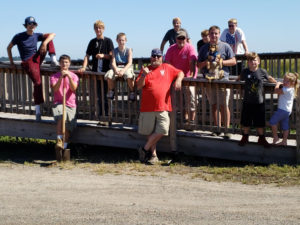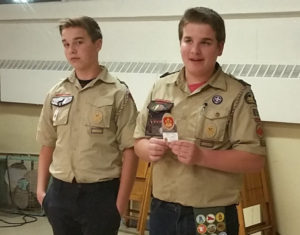
Eagle Scout projects typically provide an opportunity for a mature scout to make a contribution to the community in which they live. But this year, in West Haven, something unique occurred. Two brothers, Connor and Aidan Lynch, both 16, each chose and completed independent Eagle Scout projects that were directly connected to each other and that helped to significantly improve the Sandy Point Bird Sanctuary as a place, where shorebirds, marsh birds and migratory songbirds can thrive. Both Scouts, members of Troop 899, worked closely with their project Leader David Driver and with Audubon Connecticut, the stewards of the viewing area habitat at Sandy Point, to organize, plan, and accomplish this amazing feat!

The problem Aidan and Connor wanted to address was simple: Over the years, a number of “invasive” plants were overtaking existing native plants (bayberries, beach plums, etc.) near a viewing platform at the bird sanctuary. The native plants provide greater benefit to birds and other wildlife in the area by offering shelter, berries and proper habitat. The invasive plants (including Autumn Olive, Tree of Heaven, Multiflora Rose, Rosa Rugosa, and Mugwort) had spread through the sanctuary and had surrounded the viewing platform overlooking the marsh, making it hard for the native plants to survive and difficult for the public to enjoy views of the marsh.
Connor’s project focused on organizing a group of volunteers to remove these invasive plants and to create more space for existing native plants to flourish near the viewing area.
About the same time, Aidan was planning his own project. He decided to build on his brother’s work by designing a project to plant native species of plants where the invasive plants were removed in order to help restore a healthy and natural habitat at the Sanctuary.
“When the Scouts approached us about helping out with the work around the viewing platform, we were thrilled. Removing invasives and replanting native plants is hard work, but it gets a lot easier when more people are involved” commented Corrie Folsom-O’Keefe, Bird Conservation Programs Manager for Audubon Connecticut.
On July 28 and 29, Connor implemented the project he had organized and led a team of 27 volunteers to remove the invasive plants and to clear the area around the viewing platform. In addition to assistance from his own troop and some additional volunteers he recruited, a team of Audubon Wildlife Guards showed up to help. The Wildlife Guards, all local high school students working for Audubon Connecticut, had already begun the important work of removing invasive vegetation earlier in the summer – and they showed up to join Connor’s volunteer team on July 28 to complete the job.
Connor coordinated his removal plans with Audubon Connecticut and the Sandy Point Recovery Subcommittee of the Watershed Restoration Committee to make sure that valuable native vegetation was not damaged.
Aidan came back to the Bird Sanctuary with his volunteer Eagle Scout Project team on Sept. 15 and 16, with a mission of replenishing natural plants to support native wildlife in the area. Aidan had organized a group of more than Scouts and community volunteers to plant and water more than 45 native plants that had been donated by Audubon Cnnecticut and the Sandy Point Recovery Subcommittee. These native plants included Black and Red Chokeberry, Arrowwood Viburnum, Meadowsweet, and Beach Plum.
As a crowning touch, Aidan and his team erected three cedar posts in an adjacent natural garden on top of which the Sandy Point Recovery effort leaders will place a replica of a full-scale snowy egret, a symbol of this important area.
According to Georgianna Jette, who oversees the Sandy Point Recovery effort, “The Eagle Scout project has been instrumental in the ongoing restoration of Sandy Point. We commend the scouts and their leaders for the hard work and dedication they have shown toward making a difference in our community.”
Over the last few years, Sandy Point has become a significant destination for ‘birders’ who come to see threatened birds like the Piping Plover and other coastal species such as Snowy Egrets, Least Terns, and Great Blue Herons. In recent years, Osprey families have also begun to nest in the vicinity of the sanctuary at Old Field Creek and use the water off of Sandy Point as fishing territory.
These Eagle Scout projects helped to reshape the natural environment at Sandy Point, by bringing together over fifty volunteers to ultimately create a well-balanced habitat to support bird and wildlife populations for many generations to come. The assistance of the Eagle Scouts and Boy Scouts was vital to the realization of Audubon Connecticut’s goal of improving habitat around the viewing area, and a great example of how local organizations can partner on community projects.
The viewing platform area now has a clear view of the marsh and a native plant garden that is no longer blocked by the presence of abundant invasive species. There was benefit for the community, for wildlife, for Audubon Connecticut – and a lasting memory for the two Scouts themselves – all because two brothers decided they wanted to make a meaningful difference in their community.
This project was supported by funds awarded to Audubon Connecticut by the Long Island Sound Futures Fund.